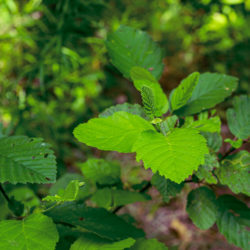Etymology
Alnus is Latin for alder, and incana is Latin for gray or hoary.
Garden Uses
Good component for wildlife or wetland gardens. Alder often grows with willows in wetlands, but does not tolerate standing water as well as willows; alder does tolerate some end-of-season dryness. It also tolerates nutrient-poor soil.
Overview
A multi-stemmed, deciduous, soft-wood shrub, up to 30 ft tall. It is common in wetlands and on moist forest edges and stream banks, often forming dense thickets. Root nodules, working with actinomycete bacteria in the soil, are nitrogen fixing, such that forest trees such as ash, tupelo, and poplar are healthier in areas where alder is present. Alnus incana is divided into two subspecies in North America, the eastern speckled alder and the western thin-leaf alder, which is more tree-like.
Leaves and Stems
Leaves are alternate, simple, oblong (4-9 inches in length), with toothed edges and straight branched veins. They grow one per node on stalks. Bark of adult plants is brown or gray, and remains thin and smooth, with numerous pores (lenticels) that provide the speckled appearance. Branch and stem diameter remains under 5 inches. Individual stem life span is 14 years on average, but clumps of clones may last up to 100 years. Roots are shallow and spreading.
Flowers
Flowers come before leaf-out. Wind-born pollination occurs between plants (monoecious). Male catkins grow in clusters of 2 or 4, and are up to 3 inches long and pendulous at maturity. These drop in the late spring, after pollination. Female catkins are woody, less than 1 inch long, and appear to be small cones, growing in clusters of 2 to 6. The woody cones remain on the stems into the winter.
Fruit/Seed
Strobile, resembles a small woody cone, with 1 to 4 seeds per cone scale, disperse in autumn and into winter.
Animal Associates
Secondary browse for deer and moose. Often the primary wood in beaver dams and lodges. Songbirds eat the seeds, while squirrels eat the catkins.
Propagation
Seed or root spread.
Garden Location
Library Garden (see garden map)
Sources
Plant Profile by Kate O'Dell

